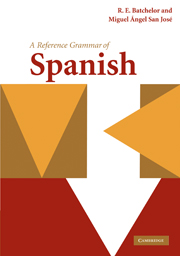Book contents
- Frontmatter
- Contents
- Preface/Prólogo
- Acknowledgments/Agradecimientos
- Abbreviations/Abreviaturas
- Introduction to the Spanish language/Introducción a la lengua española
- Part I
- 1 Register/Registro
- 2 Alphabet, spelling, pronunciation/Alfabeto, ortografía, pronunciación
- 3 Stress and accent marks/Acento tónico y acento ortográfico
- 4 Punctuation, upper case, lower case/Puntuación, mayúsculas, minúsculas
- 5 Apocopation/Apócope
- 6 Agreement/Concordancia
- Part II
- Part III
- Part IV
- Part V
- Part VI
- Part VII
- Part VIII
- Part IX
- Part X
- Appendix I Verb tables/ Tablas de verbos
- Appendix II Glossary/Glosario
- Bibliography/Bibliografía
- General index/Índice general
- Subjunctive index/Índice del subjuntivo
5 - Apocopation/Apócope
from Part I
Published online by Cambridge University Press: 05 June 2012
- Frontmatter
- Contents
- Preface/Prólogo
- Acknowledgments/Agradecimientos
- Abbreviations/Abreviaturas
- Introduction to the Spanish language/Introducción a la lengua española
- Part I
- 1 Register/Registro
- 2 Alphabet, spelling, pronunciation/Alfabeto, ortografía, pronunciación
- 3 Stress and accent marks/Acento tónico y acento ortográfico
- 4 Punctuation, upper case, lower case/Puntuación, mayúsculas, minúsculas
- 5 Apocopation/Apócope
- 6 Agreement/Concordancia
- Part II
- Part III
- Part IV
- Part V
- Part VI
- Part VII
- Part VIII
- Part IX
- Part X
- Appendix I Verb tables/ Tablas de verbos
- Appendix II Glossary/Glosario
- Bibliography/Bibliografía
- General index/Índice general
- Subjunctive index/Índice del subjuntivo
Summary
Below is a passage illustrating, in a limited way, how apocopation functions in Spanish. The highlighted words indicate this.
–¡Es un niño, el primer niño de la familia! –le dijo la matrona sonriendo, según mostraba al recién nacido.
Él miró de soslayo (looked out of the corner of his eye) como hubiera hecho cualquiera en esas circunstancias. Cualquier hombre puede ser padre, y quien “hace un cesto hace ciento”, lo importante es que fuera un buen hijo, no un santo, tanto no hacía falta, no un San Antonio, pero sí que fuera tan sacrificado por su familia cuan lo habían sido todos los varones de la familia durante tantas generaciones.
Le miró despacio: tenía una gran boca, que no dejaba de abrir gimiendo como un gatillo, era grande y hermoso con aquellos ojos grandes…, pero algo extraño había en el asunto que no encajaba. ¡El niño era blanco, pecoso y pelirrojo!, y él era cien por cien moreno aceitunado, como tantos corsos y, tal como su esposa y todos sus abuelos y tatarabuelos sicilianos. ¡Cuan sorprendente es la vida! ¡Cuantas sorpresas nos guarda! Pensó que debía descambiar en el mismo lote (change in the same batch), hijo y mujer.
Words affected by apocopation
Apocopation is a phenomenon which does not exist in English. It refers to the loss of final letter(s) or sound(s) of a word. It affects essentially qualifying, ordinal or indefinite adjectives.
- Type
- Chapter
- Information
- A Reference Grammar of Spanish , pp. 38 - 41Publisher: Cambridge University PressPrint publication year: 2010



